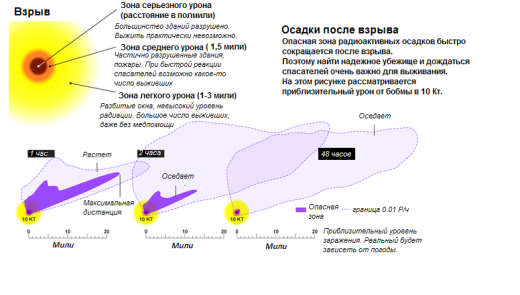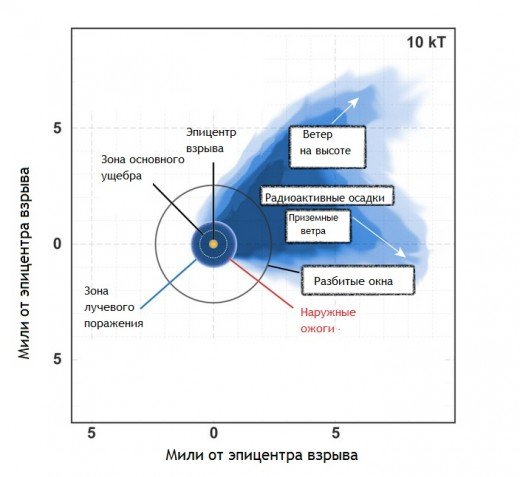So, let's say a low-power nuclear bomb exploded in your city. How long will you have to hide and where to do it to avoid the consequences in the form of radioactive fallout?
Michael Dillon, a scientist at Livermore National Laboratory, spoke about radioactive fallout and ways to survive. After numerous studies, analysis of many factors and possible developments, he developed a plan of action in the event of a disaster.
At the same time, Dillon's plan is aimed at ordinary citizens who have no way to determine where the wind will blow and what the magnitude of the explosion was.
Dillon's fallout protection technique has so far been developed only in theory. The fact is that it is designed for small nuclear bombs from 1 to 10 kilotons.
Dillon claims that now everyone associates nuclear bombs with incredible power and destruction that could have happened during the Cold War. However, such a threat seems less likely than terrorist attacks using small nuclear bombs, several times less than those that fell on Hiroshima, and simply incomparably less than those that could destroy everything if there were a global war between countries.Dillon's plan is based on the assumption that after a small nuclear bomb, the city survived and now its residents need to escape from radioactive fallout.
The diagram below shows the difference between the radius of a bomb hit in the situation that Dillon is investigating and the radius of a bomb from the Cold War arsenal. The most dangerous zone is indicated in dark blue (the psi standard is a pound/in2, which is used to measure the force of the explosion; 1 psi = 720 kg/m2).

People within a kilometer of this zone are at risk of receiving a dose of radiation and burns. The range of radiation danger after the explosion of a small nuclear bomb is much smaller than from thermonuclear weapons of the Cold War.
For example, a 10-kiloton warhead will create a radiation threat 1 kilometer from the epicenter, and radioactive fallout can travel another 10-20 miles. So it turns out that a nuclear attack today is not an instant death for all living things. Maybe your city will even recover from it.
If you see a bright flash, do not go to the window: you may get hurt while looking around. As in the case of thunder and lightning, the blast wave moves much slower than the explosion.
Now you will have to take care of protection from radioactive fallout, but in case of a small explosion, you do not need to look for a special isolated shelter. For protection, it will be possible to hide in an ordinary building, only you need to know which one.
30 minutes after the explosion, you should find a suitable shelter. In half an hour, all the initial radiation from the explosion will disappear and the main danger will be radioactive particles the size of a grain of sand that will settle around you.
Dillon explains:
If at the time of the disaster you are in an unreliable shelter that cannot provide tolerable protection, and you know that there is no such building nearby, within 15 minutes, you will have to wait half an hour and then go to look for it. Before you enter the shelter, make sure that there are no radioactive substances the size of sand particles on you.
But which buildings can become a normal shelter? Dillon tells the following:
There should be as many obstacles and distance as possible between you and the consequences of the explosion. Buildings with thick concrete walls and roofs, a large amount of land — for example, when you are sitting in a basement surrounded by earth on all sides. You can also go deep into large buildings to be as far away as possible from the open air with the consequences of the disaster.
Think about where you can find such a building in your city and how far away it is from you.
Maybe it's the basement of your house or a building with a lot of interior spaces and walls, a library with shelves of books and concrete walls, or something else. Just choose buildings that you can reach within half an hour and do not rely on transport: many will flee the city, and the roads will be completely clogged.

Let's say you have reached your shelter, and now the question arises: how long to sit in it until the threat passes? The films show different ways of events, ranging from a few minutes in a shelter and ending with several generations in a bunker. Dillon claims that they are all very far from the truth.
It's best to stay in the shelter until help arrives.
Considering that we are talking about a small bomb with a radius of less than a mile, rescuers should react quickly and begin evacuation. In the event that no one comes to help, you need to spend at least a day in the shelter, but it's still better to wait until rescuers arrive - they will indicate the right evacuation route so that you don't jump out to places with high radiation levels.
It may seem strange that it is allowed to leave the shelter after a day, but Dillon explains that the greatest danger after the explosion comes from early radioactive fallout, and they are heavy enough to settle within a few hours after the explosion. As a rule, they cover the area in the immediate vicinity of the explosion, depending on the wind direction.

These large particles are most dangerous because of the high level of radiation, which will ensure the immediate onset of radiation sickness. This is how they differ from smaller doses of radiation, which can cause cancer many years after the incident.
If you take refuge in a shelter, it will not save you from the prospect of cancer in the future, but it will prevent an early death from radiation sickness.
It is also worth remembering that radioactive contamination is not a magical substance that flies everywhere and penetrates into any place. There will be a limited region with a high level of radiation, and after you leave the shelter, you will need to get out of it as soon as possible.
This is where you need rescuers who will tell you where the border of the danger zone is and how far you need to go. Of course, in addition to the most dangerous large particles, many lighter ones will remain in the air, but they are not capable of causing immediate radiation sickness — something that you are trying to avoid after an explosion.
Dillon also noted that radioactive particles decay very quickly, so being outside the shelter 24 hours after the explosion is much safer than immediately after it.

Our pop culture continues to relish the theme of a nuclear apocalypse, which will leave only a few survivors on the planet, hiding in underground bunkers, but a nuclear attack may not be so destructive and large-scale.
So it's worth thinking about your city and figuring out where to run in case of something. Maybe some ugly concrete building, which has always seemed to you like a miscarriage of architecture, will someday save your life.